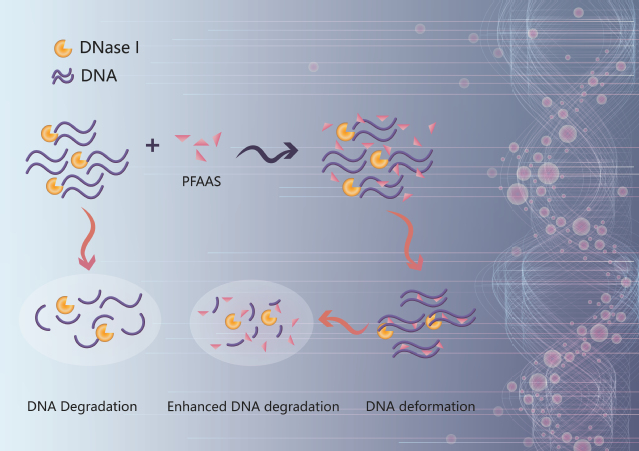
Highlights
– The dose-dependent facilitation of PFAAs on DNA degradation is found.
– PFAAs bind to thymine in DNA sequences rich in AT bases in groove binding mode.
– Hydrogen bonds and dispersion force drive PFAAs–DNA binding.
– PFAAs–DNA binding induces loose DNA structure and accelerates DNA enzymatic degradation.
– PFAAs caused medium and high molecular ecological risk in some highly contaminated countries.
Abstract: Perfluoroalkyl acids (PFAAs) are considered forever chemicals, gaining increasing attention for their hazardous impacts. However, the ecological effects of PFAAs remain unclear. Environmental DNA (eDNA), as the environmental gene pool, is often collected for evaluating the ecotoxicological effects of pollutants. In this study, we found that all PFAAs investigated, including perfluorohexanoic acid, perfluorooctanoic acid, perfluorononanoic acid, and perfluorooctane sulfonate, even at low concentrations (0.02 and 0.05 mg/L), expedited the enzymatic degradation of DNA in a nonlinear dose–effect relationship, with DNA degradation fragment sizes being lower than 1,000 bp and 200 bp after 15 and 30 min of degradation, respectively. This phenomenon was attributed to the binding interaction between PFAAs and AT bases in DNA via groove binding. van der Waals force (especially dispersion force) and hydrogen bonding are the main binding forces. DNA binding with PFAAs led to decreased base stacking and right-handed helicity, resulting in loose DNA structure exposing more digestion sites for degrading enzymes, and accelerating the enzymatic degradation of DNA. The global ecological risk evaluation results indicated that PFAA contamination could cause medium and high molecular ecological risk in 497 samples from 11 contamination-hot countries (such as the USA, Canada, and China). The findings of this study show new insights into the influence of PFAAs on the environmental fates of biomacromolecules and reveal the hidden molecular ecological effects of PFAAs in the environment.
Keywords: DNA; Enzymatic degradation; Emerging organic pollutants; Perfluoroalkyl acids; Ecological effects
DOI: 10.1016/j.eehl.2023.09.002
Authors: Chao Qin, Run-Hao Zhang, Zekai Li, Hai-Ming Zhao, Yan-Wen Li, Nai-Xian Feng, Hui Li, Quan-Ying Cai, Xiaojie Hu, Yanzheng Gao, Lei Xiang*, Ce-Hui Mo*, Baoshan Xing